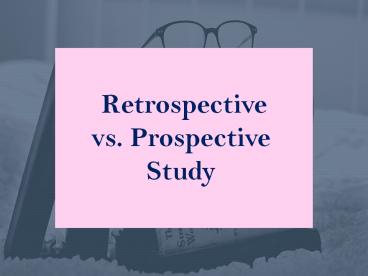Retrospective vs Prospective Study - PowerPoint PPT Presentation
Title:
Retrospective vs Prospective Study
Description:
Retrospective vs Prospective Study: Advantages, Types and Differences – PowerPoint PPT presentation
Number of Views:1776
Title: Retrospective vs Prospective Study
1
Retrospective vs. Prospective Study
2
What is a Retrospective Study?
Retrospective, the term comprises two words i.e.
retro which means in the past and spective
which means to look. Thus, a retrospective
analyzes the events of information that had
already occurred in the past. In a retrospective
study, the outcome of the reference studies has
already occurred before a retrospective study is
initiated. The researcher or an author of a
retrospective study can collect the data from the
registry. In a retrospective study, after the
collection of data, the research question is
framed.
3
What are the Advantages of Retrospective Study?
- Less time consuming and cheaper Retrospective
studies are cheaper and require less time for
completion. As the data related to the study is
already available and the researcher compiles and
compares the data between and subjects and
control, retrospective studies provide immediate
results. - Effective in rare disease Retrospective study is
quiet effective in rare diseases. Data related to
the rare disease is available from various
centres to arrive at an evaluable study
population.
4
- Initial screening Sometimes the retrospective
studies are done as an initial screening for
prospective studies. - No-follow-up Retrospective studies uses the data
already available in the literature or the
registry. Thus, there is no risk of loss of
follow-up in retrospective studies. - Large data-set Retrospective makes use of large
data-set. This may provide more accurate results.
5
What are the Types of Retrospective Studies?
- Retrospective cohort studies This study is also
known as the historic cohort study. - Case series and case reports Case reports are a
type of retrospective study in which the
researcher reports symptoms or instructive case
that was not previously seen with a medical
condition. - Case-Control Studies Case-control studies are
better than case series and case reports.
6
What is a Prospective Study?
Prospective studies are done in the present to
analyze the outcome in the future. In the
prospective study, the information is required to
be generated and is not available before the
start of the study. An example of a prospective
study is to follow-up with a group of alcohol
drinkers to identify whether drinking alcohol for
10-years is linked to liver disease. It is to be
noted that none of the subjects enrolled under
the study should have the outcome of interest.
For instance, in the above example, none of the
subjects should have liver disease before the
start of the study.
7
What are the Advantages of Prospective Study?
- New disease risk factors Prospective studies are
important in analyzing the risk factors for new
diseases for which the data is not available.
This will help in the effective management of the
disease. - Accurate results Because of well-controlled
study design and accurate generation of data, the
results provided by prospective studies are
relatively more authentic.
8
- Detailed data analysis Detailed analysis of the
outcome and other statistical factors can be done
in prospective studies. Exposure can be measured
before the outcome and the incidence and disease
process can also be determined. - Multiple outcomes Multiple outcomes can also be
obtained from prospective studies. - No risk of recall bias As the prospective study
does not require any data recollection from the
past, the risk of recall bias is eliminated.
9
What are the Various Types of Prospective Studies?
- Prospective trend studies In this study, the
samples are taken from the dynamic population in
which the individuals change over time. - Prospective panel studies In such studies, the
measurement is done on the same set of
individuals. - Prospective cohort studies In the prospective
cohort studies, the measurement is done on the
individuals from the same pool of individuals.
10
What is the Difference between Retrospective and
Prospective Study?
- Data In the prospective study the data is
generated by the researcher after enrollment of
the subjects while retrospective studies make use
of the already available information. - Control Prospective study has more control over
the subjects and data generation as compared to
retrospective studies. - Accuracy More accurate results are provided by
prospective studies due to less biasness and
optimum data control.
11
- Time and cost Prospective studies are more
time-consuming and costlier as compared to
retrospective studies. - Biasness The risk of recall biasness is
eliminated in prospective studies. - Practicality Prospective studies are both
observational and interventional while
retrospective studies are only observational. - Usefulness Prospective studies are useful in
cases of emerging new exposures while
retrospective studies are not of much use in such
scenarios.
12
- Email ID project_at_cognibrain.com
- Phone 044-49595223
- Visit us https//www.cognibrain.com/































